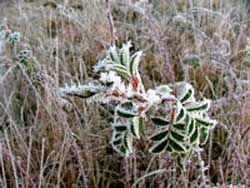Plant Protection from Cold Decoded

In response to cold, plants trigger a cascade of genetic reactions that allow them to survive. University of California, Riverside Professor of Plant Cell Biology Jian-Kang Zhu has described how a little-known biochemical reaction regulates that genetic cascade.
Zhu’s findings were published in the May 15 online version of the Proceedings of the National Academy of Sciences in a paper titled The Negative Regulator of Plant Cold Responses, HOS1 is a RING E3 Ligase That Mediates the Ubiquitation and Degredation of ICE1. Zhu co-authored the paper with UCR colleagues Chun Hai Dong and Manu Agarwal; and Yiyue Zhang and Qi Xie, from the Institute of Genetics and Development of the Chinese Academy of Sciences in Beijing.
This negative regulator, known as high expression of osmotically responsive gene 1 (HOS1), acts essentially as a biochemical gate that cuts off the plant’s cold protection, Zhu said. The HOS1 gene product interacts with another gene product known as ICE1 that kicks off the genetic cascade that provides the plant’s cold protection proteins, according to the paper. The interaction worked both in the test tube and in the live plant.
“The better we understand this molecular mechanism, the better we can control the process of increasing the plant’s freezing tolerance without causing negative impacts,” Zhu said. “This process should apply to all plants and can help us better use crops of subtropical origin such as corn, rice, avocadoes and strawberries.”
Zhu said the discovery of how HOS1 acts on plants should help his overall research efforts into how plants respond to environmental stresses such as cold, soil salinity and drought.
“From a genetic and molecular standpoint, these responses are all related,” Zhu said. “Some of the same genes are involved in all of these responses and understanding how they work can help us develop crops that can better withstand these conditions.”
Zhu said he plans on continuing his research on how HOS1 and ICE1 recognize each other and work together to help plants deal with cold weather conditions. This line of inquiry should better explain how plant cells initially respond to cold and other adverse conditions.
Media Contact
More Information:
http://www.ucr.eduAll latest news from the category: Life Sciences and Chemistry
Articles and reports from the Life Sciences and chemistry area deal with applied and basic research into modern biology, chemistry and human medicine.
Valuable information can be found on a range of life sciences fields including bacteriology, biochemistry, bionics, bioinformatics, biophysics, biotechnology, genetics, geobotany, human biology, marine biology, microbiology, molecular biology, cellular biology, zoology, bioinorganic chemistry, microchemistry and environmental chemistry.
Newest articles

After 25 years, researchers uncover genetic cause of rare neurological disease
Some families call it a trial of faith. Others just call it a curse. The progressive neurological disease known as spinocerebellar ataxia 4 (SCA4) is a rare condition, but its…

Lower dose of mpox vaccine is safe
… and generates six-week antibody response equivalent to standard regimen. Study highlights need for defined markers of mpox immunity to inform public health use. A dose-sparing intradermal mpox vaccination regimen…

Efficient, sustainable and cost-effective hybrid energy storage system for modern power grids
EU project HyFlow: Over three years of research, the consortium of the EU project HyFlow has successfully developed a highly efficient, sustainable, and cost-effective hybrid energy storage system (HESS) that…





















